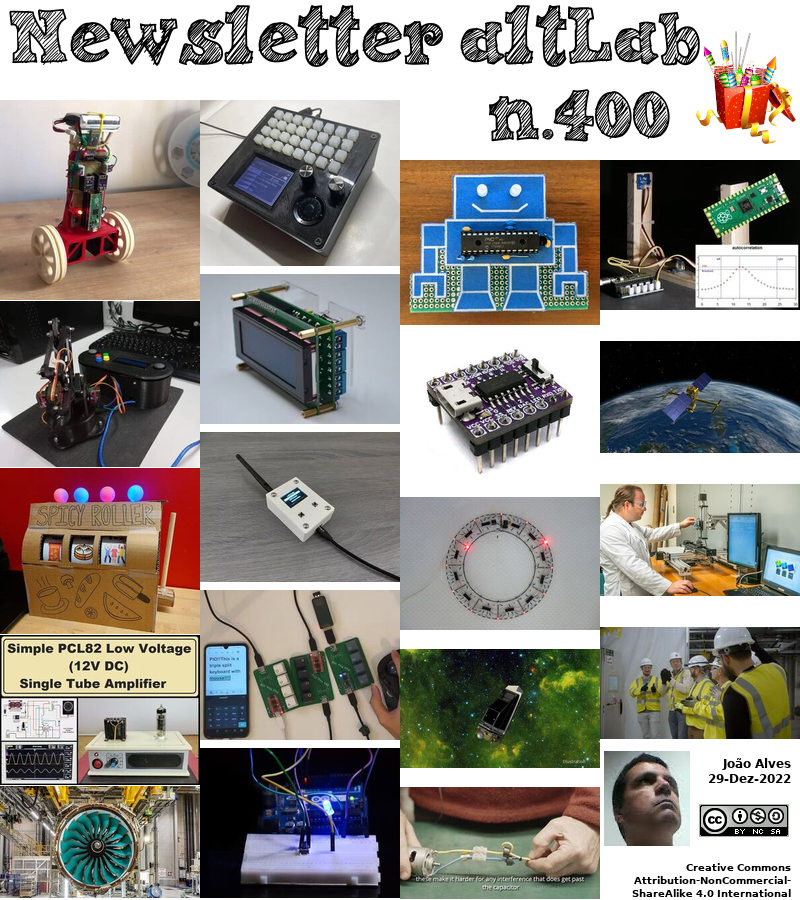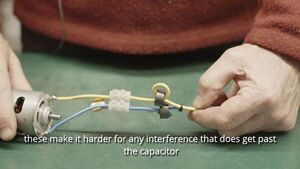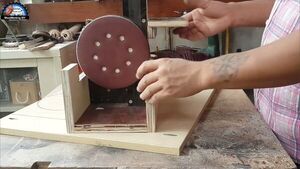2022-12-29 - Nº 400
Editorial
Esta é a Newsletter Nº 400 que se apresenta com o mesmo formato que as anteriores. Se gostar da Newsletter partilhe-a!
Todas as Newsletters encontram-se indexadas no link.
Esta Newsletter tem os seguintes tópicos:
Faz hoje anos que nascia, em 1800, o inventor norte-americano Charles Goodyear. Ele cozeu borracha misturada com enxofre e descobriu o processo de vulcanização que tornou a borracha prática como um produto comercial. Anteriormente, a borracha tinha uma utilização limitada, uma vez que congelava com força no Inverno e grudava no Verão. Após anos de experimentação persistente, Goodyear tinha criado um composto duro, curado, capaz de resistir ao calor e ao stress. Infelizmente, era um pobre homem de negócios, incapaz de lucrar com a sua invenção ou de a patentear efectivamente no estrangeiro. O nome "vulcanizado" foi aplicado pelo pioneiro inglês da borracha Thomas Hancock, usando a sugestão de um amigo para dar ao processo o nome de Vulcan, o deus romano do fogo. A Goodyear também nunca foi ligada à Goodyear Tire & Rubber Co. que foi nomeada em sua honra.
Faz também hoje anos que nascia, em 1813, o químico industrial britânico Alexander Parkes. Ele era um perito em galvanoplastia, capaz de plastificar objectos tão diversos como uma teia de aranha e flores. Patenteou um método de revestimento de tecidos de borracha para os impermeabilizar (1841), um processo de galvanoplastia (1843), e um método de extracção de prata do minério de chumbo por adição de zinco (1850). Produziu o primeiro plástico (1855), a que chamou Parkesine, dissolvendo o nitrato de celulose em álcool e cânfora contendo éter. O resultado sólido duro podia ser moldado quando aquecido, mas ele não encontrou mercado para o material. (Isto foi redescoberto na década de 1860 por John Wesley Hyatt, um químico americano, que lhe deu o nome de celulóide e o comercializou com sucesso como um substituto do marfim).
Faz igualmente hoje anos que nascia, em 1856, o matemático holandês Thomas Joannes Stieltjes. Ele foi um pioneiro no campo dos problemas do momento e contribuiu para o estudo das fracções contínuas. O Instituto Thomas Stieltjes de Matemática da Universidade de Leiden, dissolvido em 2011, recebeu o seu nome, assim como a integral Riemann-Stieltjes.
Por fim, faz hoje anos que nascia, em 1905, o engenheiro electrotécnico franco-americano Henri-Gaston Busignies. Ele é responsável pela invenção de localizadores de direcção de alta frequência (HF/DF, ou "Huff Duff") que permitiram à Marinha dos EUA durante a Segunda Guerra Mundial detectar transmissões inimigas e localizar rapidamente a direcção de onde vinha uma transmissão rádio. Busignies inventaram a bússola radio-eléctrica (1926) quando ainda era estudante no Colégio Jules Ferry, em Versalhes, França. Em 1934, começou a desenvolver o localizador de direcção com base na sua anterior bússola radio. Busignies desenvolveu o indicador de alvo móvel para radar em tempo de guerra. Ele apagou do ecrã do radar todos os ecos de objectos estacionários e deixou apenas ecos de objectos em movimento, tais como aviões.
Em 1987, o cosmonauta Yuri Romanenko regressa à Terra, terminando o seu recorde de 326 dias de voo espacial em órbita da Terra na estação espacial de Mir. A nave espacial Soyuz aterrou num local coberto de neve no Cazaquistão. A sua estadia no espaço bateu o anterior recorde soviético de 237 dias. Romanenko entrou em órbita em 6 de Fevereiro de 1987 com o engenheiro de voo Alexander Laveikin que sofreu problemas cardíacos cinco meses mais tarde e foi substituído por Alexander Alexandrov. Eles conduziram 1.000 experiências em biologia, medicina, processamento de materiais e geologia. Romanenko e Alexandrov utilizaram o laboratório gigante de astrofísica Kvant (Quantum) ligado à Mir para recolher dados de partes remotas do sistema solar. Num total de 3 missões espaciais, acumulou 430,76 dias no espaço.
Na Newsletter desta semana apresentamos diversas noticias, artigos científicos, projetos de maker assim como alguns videos interessantes. São apresentados os livros "The Linux Command Line" e "Adventures with the Linux Command Line". Esta é a newsletter Nº400. Durante 400 semanas preparei esta newsletter com os artigos que fui recolhendo que seriam úteis. Este projeto, se é que assim se pode chamar, foi lançado a 5 de Maio de 2015 e ao longo destes quase sete anos foram indexados aqui na newsletter mais de vinte e dois mil artigos das mais diversas origens e assuntos. Sendo esta a ultima newsletter do ano, resta-me desejar um excelente ano de 2023 a todos e esperar que este novo ano seja melhor que o atual.
 João Alves ([email protected])
João Alves ([email protected])
O conteúdo da Newsletter encontra-se sob a licença  Creative Commons Attribution-NonCommercial-ShareAlike 4.0 International License.
Creative Commons Attribution-NonCommercial-ShareAlike 4.0 International License.
Novidades da Semana
Outras Notícias
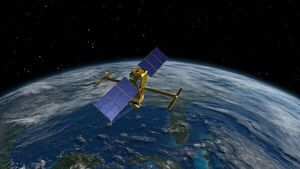
Watch the Latest Water Satellite Unfold Itself in Space
"The Surface Water and Ocean Topography (SWOT) satellite launched into Earth orbit on Friday, Dec. 16, from Vandenberg Space Force Base in central California, and engineers are working to prepare the mission to begin measuring the height of water on over 90% of Earth’s surface, providing a high-definition survey of our planet’s water for the first time. But before it can do that, the satellite would need to unfold its large mast and antenna panels (see above) after successfully deploying the solar panel arrays that power the spacecraft. The mission monitors and controls the satellite using telemetry data, but it also equipped spacecraft with four customized commercial cameras to record the action. The solar arrays fully deployed shortly after launch, taking about 10 minutes. The antennas successfully deployed over four days, a process that was completed on Dec. 22. The two cameras focused on the KaRIn antennas captured the mast extending out from the spacecraft and locking in place but stopped short of capturing the antennas being fully deployed (a milestone the team confirmed with telemetry data.)" [...]
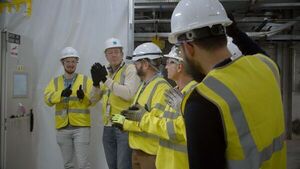
First EUV light marks key milestone for production of Intel 4 in Europe
"Earlier this year Fab 34 in Ireland took delivery of its first EUV lithography system, a key enabler of Intel 4 process technology. The system, made by Dutch manufacturer ASML, is arguably the most complicated piece of machinery humans have ever built. Since its arrival, local teams have been working through the installation phase and this week reached an important moment as the EUV scanner generated its 13.5 nanometre wavelength light for the first time in Ireland. This is a key milestone on the path towards high volume production of Intel 4 technology and is the first time a high volume EUV scanner will be used in Europe. Preparing for a critical milestone The EUV system consists of 100,000 parts, 3,000 cables, 40,000 bolts and more than a mile of hosing. It took 18 months of design and construction activity to prepare the Fab 34 building to receive the machine." [...]
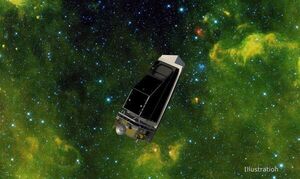
Construction Begins on NASA’s Next-Generation Asteroid Hunter
"NEO Surveyor is the first purpose-built space telescope that will advance NASA’s planetary defense efforts by finding and tracking hazardous near-Earth objects. A space telescope designed to search for the hardest-to-find asteroids and comets that stray into Earth’s orbital neighborhood, NASA’s Near-Earth Object Surveyor (NEO Surveyor) recently passed a rigorous technical and programmatic review. Now the mission is transitioning into the final design-and-fabrication phase and establishing its technical, cost, and schedule baseline. The mission supports the objectives of NASA’s Planetary Defense Coordination Office (PDCO) at NASA Headquarters in Washington. The NASA Authorization Act of 2005 directed NASA to discover and characterize at least 90% of the near-Earth objects more than 140 meters (460 feet) across that come within 30 million miles (48 million kilometers) of our planet’s orbit. Objects of this size are capable of causing significant regional damage, or worse, should they impact the Earth." [...]

Rolls-Royce UltraFan technology demonstrator build complete and getting ready to test
"Rolls-Royce today announced it has completed building and is preparing to test its UltraFan®, technology demonstrator. In a major milestone for the programme, the demonstrator engine was transported from the build workshop and into Testbed 80 in Derby, UK where it was mounted in preparation for testing. The first test of the demonstrator is expected to take place early next year and will be operated using 100% Sustainable Aviation Fuel. Chris Cholerton, President of Rolls-Royce Civil Aerospace, said: “Seeing the UltraFan demonstrator come together and getting ready for test in Testbed 80 is a great way to end the year. We have all been waiting for this moment, which is such an important milestone for the programme and for the team who have worked on it. The next stage will be to see UltraFan run for the first time on 100% Sustainable Aviation Fuel in 2023, proving the technology is ready to support more sustainable flight in the future.” Combining a brand new engine design with a suite of technologies to support sustainable air travel for decades to come, the UltraFan demonstrator has a fan diameter of 140 inches and offers a 25% fuel efficiency improvement compared with the first generation of Trent engine." [...]
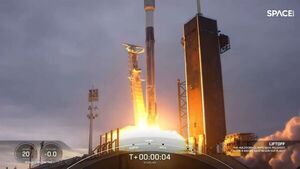
SpaceX launches 54 upgraded Starlink internet satellites and nails rocket landing at sea in 60th flight of the year
"SpaceX launched the first batch of a new generation of Starlink satellites into orbit early Wednesday (Dec. 28) and nailed a rocket landing at sea to mark a record 60th flight of the year. A Falcon 9 rocket topped with 54 upgraded Starlink internet satellites — the first generation 2 (Gen2) versions of the SpaceX fleet — lit up the predawn sky with a smooth launch at 4:34 a.m. EST (0934 GMT) from the Cape Canaveral Space Force Station in Florida. "Under our new license, we are now able to deploy satellites to new orbits that will add even more capacity to the network," Jesse Anderson, a SpaceX production and engineering manager, said during live launch commentary. "Ultimately, this enables us to add more customers and provide faster service, particularly in areas that are currently oversubscribed." About eight minutes after liftoff, the Falcon 9 first stage returned to Earth with a landing on the SpaceX drone ship A Shortfall of Gravitas in the Atlantic Ocean, where rough recovery weather threatened to delay the launch. The touchdown marked a successful end to SpaceX's 60th launch of SpaceX in 2022, nearly doubling the 31 launches set as a SpaceX record in 2021." [...]

NASA Explores a Winter Wonderland on Mars
"Cube-shaped snow, icy landscapes, and frost are all part of the Red Planet’s coldest season. When winter comes to Mars, the surface is transformed into a truly otherworldly holiday scene. Snow, ice, and frost accompany the season’s sub-zero temperatures. Some of the coldest of these occur at the planet’s poles, where it gets as low as minus 190 degrees Fahrenheit (minus 123 degrees Celsius). Cold as it is, don’t expect snow drifts worthy of the Rocky Mountains. No region of Mars gets more than a few feet of snow, most of which falls over extremely flat areas." [...]
Ciência e Tecnologia
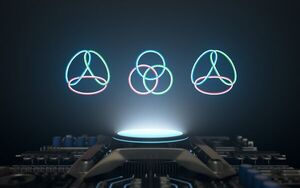
A peculiar protected structure links Viking knots with quantum vortices
"Mathematical analysis identifies a vortex structure that is impervious to decay Scientists have shown how three vortices can be linked in a way that prevents them from being dismantled. The structure of the links resembles a pattern used by Vikings and other ancient cultures, although this study focused on vortices in a special form of matter known as a Bose-Einstein condensate. The findings have implications for quantum computing, particle physics and other fields. Postdoctoral researcher Toni Annala uses strings and water vortices to explain the phenomenon: ‘If you make a link structure out of, say, three unbroken strings in a circle, you can’t unravel it because the string can’t go through another string. If, on the other hand, the same circular structure is made in water, the water vortices can collide and merge if they are not protected.’ ‘In a Bose-Einstein condensate, the link structure is somewhere between the two,’ says Annala, who began working on this in Professor Mikko Möttönen’s research group at Aalto University before moving back to the University of British Columbia and then to the Institute for Advanced Study in Princeton. Roberto Zamora-Zamora, a postdoctoral researcher in Möttönen’s group, was also involved in the study." [...]

A greener internet of things with no wires attached
"Wirelessly powered large-area electronics could enable a cheaper and greener internet of things. Emerging forms of thin-film device technologies that rely on alternative semiconductor materials, such as printable organics, nanocarbon allotropes and metal oxides, could contribute to a more economically and environmentally sustainable internet of things (IoT), a KAUST-led international team suggests. The IoT is set to have a major impact on daily life and many industries. It connects and facilitates data exchange between a multitude of smart objects of various shape and size — such as remote-controlled home security systems, self-driving cars equipped with sensors that detect obstacles on the road, and temperature-controlled factory equipment — over the internet and other sensing and communications networks. This burgeoning hypernetwork is projected to reach trillions of devices by next decade, boosting the number of sensor nodes deployed in its platforms. Current approaches used to power sensor nodes rely on battery technology, but batteries need regular replacement, which is costly and environmentally harmful over time." [...]
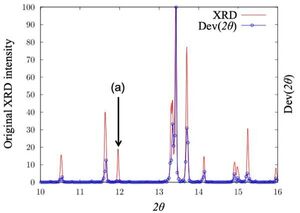
Finding Hidden Regularities in Nature: JAIST Researchers Apply Deep Learning to X-Ray Diffraction
"The auto-encoder technique uses a neural network to facilitate the discovery of hidden features of materials that cannot be easily recognized by humans X-ray diffraction (XRD) is an essential technique to identify the structures and compositions of newly developed materials. However, XRD patterns consist of multiple peaks, and it is not always possible to judge which ones are relevant to describe the features of the material. Researchers from Japan have recently proposed a neural network that uses the auto-encoder technique to permit the in-depth analysis of XRD patterns to reveal features that might not be identified by humans. X-ray diffraction (XRD) is an experimental technique to discern the atomic structure of a material by irradiating it with x-rays at different angles. Essentially, the intensity of the reflected x-rays becomes high at specific irradiation angles, producing a pattern of diffraction peaks. An XRD serves as a fingerprint for a material since each substance produces a unique pattern." [...]
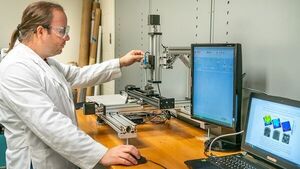
Using Additive Manufacturing To Detect Counterfeit Parts
"Texas A&M Researchers are applying metal additive manufacturing techniques to embed a hidden cache of information within products to help combat counterfeited goods. Ensuring manufactured goods and components have not been copied and replaced illegally by counterfeited goods is a high-priority concern of the manufacturing and defense industries in the U.S. and around the world. A potential solution would hold wide-reaching impacts and implications in various areas ranging from enhancing biomedical implants to protecting national defense assets. Texas A&M University researchers have developed a method of imprinting a hidden magnetic tag, encoded with authentication information, within manufactured hardware during the part fabrication process. The revolutionary process holds the potential to expose counterfeit goods more easily by replacing physical tags — such as barcodes or quick response (QR) codes — with these hidden magnetic tags, which serve as permanent and unique identifiers. The project, titled “Embedded Information in Additively Manufactured Metals via Composition Gradients for Anti-Counterfeiting and Supply Chain Traceability,” is a faculty partner project supported by the SecureAmerica Institute." [...]
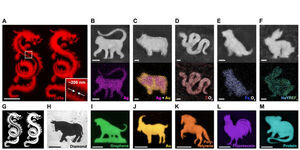
Shrinking Hydrogels Enlarge Nanofabrication Options
"Researchers from Pittsburgh and Hong Kong print intricate, 2D and 3D patterns Carnegie Mellon University's Yongxin (Leon) Zhao and the Chinese University of Hong Kong's Shih-Chi Chen have a big idea for manufacturing nanodevices. Zhao's Biophotonics Lab develops novel techniques to study biological and pathological processes in cells and tissues. Through a process called expansion microscopy, the lab works to advance techniques to proportionally enlarge microscopic samples embedded in a hydrogel, allowing researchers to be able to view fine details without upgrading their microscopes. In 2019, an inspiring conversation with Shih-Chi Chen, who was visiting Carnegie Mellon as an invited speaker and is a professor at the Chinese University of Hong Kong's Department of Mechanical and Automation Engineering, sparked a collaboration between the two researchers. They thought they could use their combined expertise to find novel solutions for the long-standing challenge in microfabrication: developing ways to reduce the size of printable nanodevices to as small as 10s of nanometers or several atoms thick. Their solution is the opposite of expansion microscopy: create the 3D pattern of a material in hydrogel and shrink it for nanoscale resolution." [...]
Documentação
A documentação é parte essencial do processo de aprendizagem e a Internet além de artigos interessantes de explorar também tem alguma documentação em formato PDF interessante de ler. Todos os links aqui apresentados são para conteúdo disponibilizado livremente pelo editor do livro.

The Linux Command Line
"Designed for the new command line user, this 555-page volume covers the same material as LinuxCommand.org but in much greater detail. In addition to the basics of command line use and shell scripting, The Linux Command Line includes chapters on many common programs used on the command line, as well as more advanced topics. " [...]
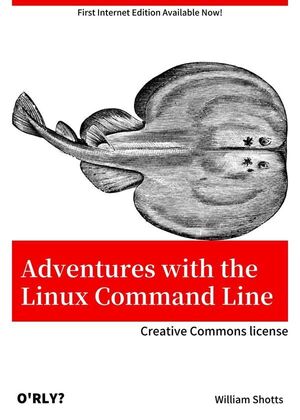
Adventures with the Linux Command Line
"In this 250+ page sequel/suplement to The Linux Command Line we'll look at even more cool tools and fun command line topics. With 14 action-packed chapters, it's perfect for makers, students, and anyone wanting to learn additional Linux history, techniques, and skills. " [...]
Projetos Maker
Diversos Projetos interessantes.
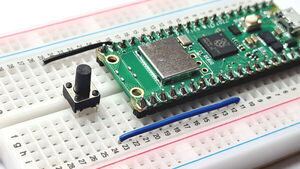
How to Add a Raspberry Pi Pico Reset Button
"Resetting the Pi Pico usually requires unplugging the USB cable either from the Pi Pico or your computer. It’s a lot easier to add a reset button to your circuit which you can press instead of unplugging cables. It’s easy to do and I tend to add a reset button before starting any Pi Pico or Pi Pico W project. While developing with the Pi Pico it is often required to reset the board. This is usually due to a number of reasons: - Restart you code so it can start it from the beginning - Restart due to a communications issue with your computer via USB - Swap into mass-storage mode so you can drag-n-drop a new UF2 file" [...]
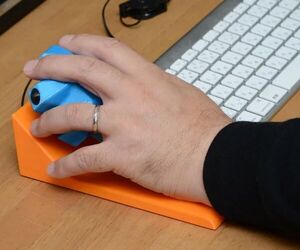
"Space Mushroom" : Full 6 DOFs Controller for CAD Applications
"Very simple and easy to assemble 3D mouse for CAD softwares. It can input full 6 degrees of freedom (rigid motion) simultaneously. - Very easy to assemble. - Tripod mount (thread hole) is on the bottom side of the triangle shaft. - Two types of base (tilted and horizontal types) are provided (personally I prefer tilted type.) Supplies: - Three analog joystick sensors with board." [...]
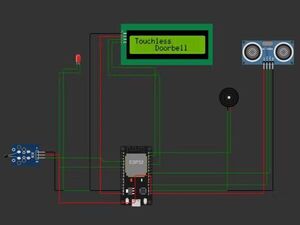
Touchless Doorbell
"To avoid the Germ infection The team has designed the "Touchless Doorbell" Story Motivation The team decided it would be better to design this project because the society was struggling with the issue of people becoming infected through physical contact and closeness. To solve this, we are implementing Touchless Door Bells, which will lessen physical contact and sense the stranger’s distance and temperature so that the owner can be alerted that someone has arrived. Objective The ultrasonic sensor recognize the gesture of person and then employs an LM35 sensor to assess the temperature if the distance satisfies the specifications. The system buzzes, displays the relevant message, and notifies the owner whether or not to let the individual inside the house based on the temperature. The data is subsequently uploaded to Thingspeak, from which it is tweeted to the account of the owner on Twitter. Algorithum Step 1 : Power the nodemcu and connect the sensors Step 2: check the working of all the sensors like ultrasonic sensor, Lm35, buzzer, lcd Step 3:- The ultrasonic Sensor and the Lm35 Should be mounted properly Step 4 :- Dump the code to nodemcu Step 5:- As the gesture is detected by the ultrasonic Sensor the buzzer beeps once." [...]
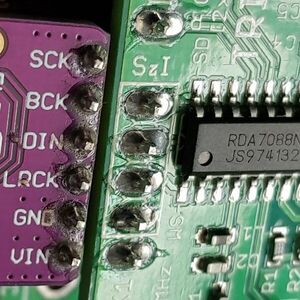
I2S output FM Tuner
"I2S(inter-IC sound bus) output FM Tuner using RDA7088 with NEC protocol IR remote control using PIC10F200 microcontroller. I2S output FM Tuner using RDA7088. I2C bus controlled by PIC10F200. 48ksps 16 bit stereo output. Channel selection using IR remote control. RDA Microelectronics make RDA7088N is a simple FM Tuner with stereo output." [...]
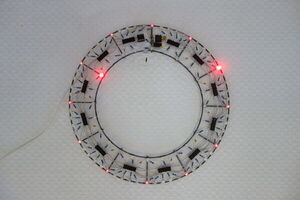
Clock sculpture
"One day I wondered if it would be possible to make a wall clock out of two concentric rings with leds and all electronics suspended between them. Well, now I know. For this clock there's no need for a circuit board, in fact, it looks even cooler without. Especially with blinkenleds. This article is about my first circuit sculpture. Design After working on the wedding gift for Jeroen and Mingming, I thought a lot about making cool looking electronics." [...]

Robotic Arm Ft. Arduino Mega, TheGHIZmo, Aarav G
"This project consists on building and programming a robotic arm able of performing movements manually by joystick control and repeating recorded movements, all controlled by an Arduino Mega. The main reason for using the Arduino Mega is because of its large number of I/O pins plus extra GND and VCC sockets. The robotic arm can etiher be operated directly through the Manual Mode or reproduced an Automated programmed movement or even a Party move . This project has arisen for the development of the final practice of the subject of Creative Electronics, a subject belonging to the University of Malaga (UMA), School of Telecommunications. The whole project has been carried out by Clara Rubio Almagro, Laura Snchez Snchez and Daniel Bazo Correa, students of Electronic Systems Engineering at the University of Mlaga . The main idea, the structure of the robotic arm, the starting code and the tools/utilities can be found in this link." [...]

How to use oneButton Library
"Hey Guys, In this tutorial I'm going to show you How to use the one-button library in an easy way. This Arduino library is improving the usage of a single button for input. It shows how to use a digital input pin with a single pushbutton attached for detecting some of the typical button press events like single clicks, double clicks, and long-time pressing. This enables you to reuse the same button for multiple functions and lowers hardware investments. " [...]
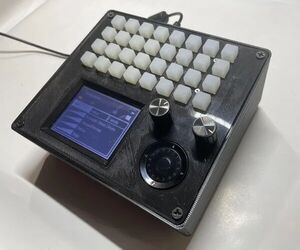
A Drum Machine for Bassists (and Others) to Practice With
"When I'm practicing bass I don't like fiddling around with phone apps or something on my PC when I want to set up a rhythmic accompaniment. So I made this - a programmable rhythm box based on the VS1053 MIDI chip. Proper knobs, buttons and flashing lights! Beware! There may be dragons. This is not a beginner's project." [...]
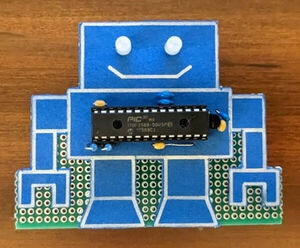
PIC32/6502 Blinky Robot
"The PIC32 robot from my 2022 Project Goals is finally finished! Building it was a fun way to learn about the MIPS architecture and programming the PIC32. It was also a chance to work on a 6502 emulator that will be useful for other projects. As far as robots go, this is not a very useful one since all it does is blink its eyes every few seconds. The interesting part is how it does the blinking. Rather than switching the LEDs on then delaying a while before switching them off, the robot runs several layers of emulation with the innermost emulated system blinking the LEDs as fast as possible." [...]

DIY Simple PCL82 Low Voltage (12V) Tube Amplifier
"How to make a very simple single Valve Amplifier that also works at low voltage and is powered by 12V DC A valve amplifier or tube amplifier is a type of electronic device that uses vacuum tubes to increase the amplitude or power of a audio signal. Until the invention of the transistor, all electronic amplification was produced by valve (tube) amplifiers. Nowadays, this amplifiers are again popular among audiophiles, and their price is usually very high. Valve amplifiers produce greater amounts of total harmonic distortion, but this type of distortion (2nd harmonic) is not as disturbing to the ear, and is perceived as a "warm" pleasant sound, especially when playing instruments where this amplifiers are still indispensable. This type of amplifiers are not very popular with DIYers mostly because they use high voltages (more than 200V) which are usually difficult to perform and are very dangerous. This time I will describe to you how to make a very simple single tube amplifier that also works at low voltage and is powered by 12V DC." [...]

A New Perspective on 3D Printing!
"A few weeks ago I saw a video on Reddit of someone that added a tiny camera to the extruder assembly. The view was truly mesmerizing! It was then I decided to make this myself! Finding a mount for the camera was not easy. All the mounts I found were either too far away from the nozzle or out of focus, so I decided to design my own using Fusion 360. Using a tiny plastic magnifying lens enabled me to get the camera closer while still being in focus." [...]

LOTP Two-Wheeled Self-Balancing Robot
"It is an Open Source DIY- project. It can maintain its own balance and can be controlled remotely via Bluetooth connection. LOTP Two-Wheeled Self-Balancing Robot Project is an open source –DIY- project. It can maintain its own balance and can be controlled remotely via wireless connection. Its features are: - Fusion 360 designed - Bluetooth control is available - Raspberry Pi Pico used as a micro controller - Software is written in Python - Stepper Motors are used to perform movement - PID Controller implemented - Self - Balancing - Open Source - DIY Project All project files & documents are shared at the GitHub link. The contents of the shares are as follows1 1." [...]
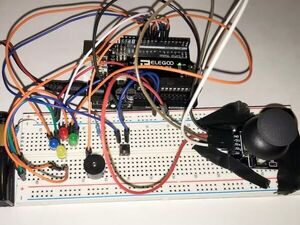
Simon Says With Joystick
"An LED Simon Says game with a joystick and buzzer. I thought I would try to make a game with my Arduino. I have programmed other things in the past and thought it time I actually learned to program my Arduino. I thought Simon Says would be easy to make. I didn't have enough buttons (I guess I've lost some) but I did have a joystick, so I thought I would make it with a joystick instead of buttons. " [...]
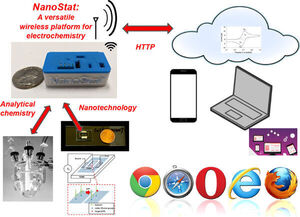
NanoStat: An open source, fully wireless potentiostat
"We present an open source, fully wireless potentiostat (the “NanoStat”) for applications in electrochemistry, sensing, biomedical diagnostics, and nanotechnology, based on only 2 integrated circuit chips: A digital microcontroller with integrated on board WiFi and file/web server hardware/software, and an analog front end. This versatile platform is fully capable of all modern electrochemisty assays, including cyclic voltammetry, square wave voltammetry, chronoamperometry, and normal pulse voltammetry. The user interface is a web browser connected over http. All the code (firmware, HTML5, JavaScript) is hosted by the NanoStat itself without the need for any additional software. The total size is mm and battery operation for 6 h is demonstrated, possible to extend to weeks or months in sleep mode. We anticipate that the applications of this could be very broad, from biomedical sensing in the clinic, to remote monitoring of unattended “motes”, to even possibly sensing aerial pathogens such as COVID in large public spaces without the need for anything other than a web browser for remote monitoring from anywhere in the world." [...]
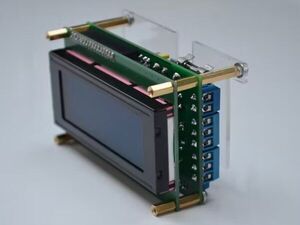
Mini serial console with three different serial ports
"This is my "poor man's HID" that I want in my projects to enter data and display messages. Story It is a simple serial console that can be used for data display and data input. It can handle three (different) serial interfaces at the same time: 3.3V TTL for single-board computers and microcontrollers, via traditional RS-232 and serial over USB. I. Hardware 1. Technical data - Supply voltage: 5 V DC - Supply current: approx." [...]

Arduino Based AC Voltage Control using Zero Voltage Crossing
"Usually, our home appliances run on single-phase AC voltage. And in India usually, a house is supplied with single-phase AC voltage with a voltage range of about 220-240 volts at 50Hz(your supply may be different). AC voltage in its first half cycle starts increasing the voltage from 0 to 220-240 as its peak voltage and when it reaches the peak voltage it starts decreasing from 220-240 to 0. Now in the next half cycle, the voltage starts increasing but in the negative direction and ultimately reaches to its peak (say -220v-240v) and again it will start decreasing and continue to reach zero voltage. If we draw a graph of this voltage nature with respect to time. We will find it as a sine wave." [...]
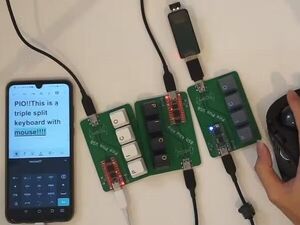
Pico-PIO-USB
"USB host/device implementation using PIO of raspberry pi pico (RP2040). You can add additional USB port to RP2040. Resource Usage - Two PIO - One PIO is for USB transmitter using 22 instruction and one state machine - Another PIO is for USB receiver using 31 instruction and two state machine - Two GPIO for D+/D- (Series 22ohm resitors are better) - 15KB ROM and RAM - (For Host) One 1ms repeating timer - (For Device) One PIO IRQ for receiver" [...]
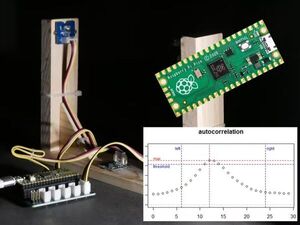
Over-engineered dual core light barrier
"If the Raspberry Pi Pico already has two cores, why not use both for a light barrier with Barker-coded pulse sequences and autocorrelation? " [...]
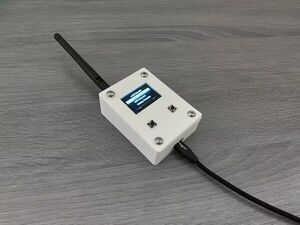
n-RFi Monitor
"The n-RFi Monitor is a 2.4GHz band and WiFi analyzer toolkit made with the D1 Mini and NRF24L01. It features a 2.4GHz traffic analyzer, a WiFi scanner, and a Vicinity Detector. " [...]
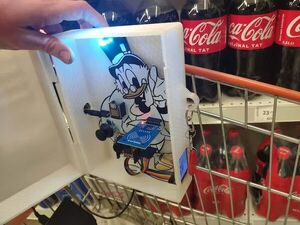
IoT AI-driven Smart Grocery Cart w/ Edge Impulse
"Provide a checkout-free shopping experience letting customers create an online shopping list from products in their cart and pay via email. Especially after the recent success of Amazon Go cashierless convenience stores, there is a surge in adaptations of this relatively new approach to the shopping experience, including computer vision, sensor fusion, and deep learning. Since the nonpareil concept of cashierless stores is to make shoppers avoid tedious checkout lines and self-checkout stations, the stores equipped with this technology improve the customer experience and increase profit margins comparatively. While implementing this technology in a grocery or convenience store, smart grocery carts are the most prominent asset to provide an exceptional customer experience like Amazon Go. Although smart grocery carts improve the customer experience and plummet maintenance costs by providing an automated product tracking and payment system, the current integration methods are expensive investments for small businesses in the food retail industry since these methods require renovating (remodeling) store layouts or paying monthly fees to cloud services. After perusing recent research papers on smart grocery carts, I noticed there is no appliance devised for converting regular grocery carts into smart grocery carts without changing anything else in an existing establishment." [...]

Perpetual Battery-Free Weather Station
"It’s now possible to build remote, low-power microcontroller projects that can operate indefinitely without batteries and still not crash, even if power is interrupted. Let that sink in. As an example, we’ll show you how to build a LoRa-based weather station that’s powered solely by solar panels. Its code is written in CircuitPython, running on a popular hobby-grade microcontroller board: the Adafruit Metro M0 Express. The novelty is that it can keep the state of the weather measurement program, even during periods of complete darkness when it runs out of power. This is called intermittent computing or perpetual computing, and it opens up a new world of sustainable electronics, where many applications will work well, and practically forever, without reliance on a battery." [...]
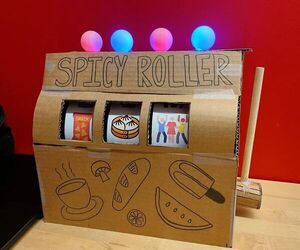
Spicy Roller - Meal Desicion Machine
"I always spend a lot of time to decide what to eat since I have so many options and it's hard to choose one from them. Because of this, I want to design a product to decide it for me. Speaking of randomness, the slot machine is the first thing that comes to my mind. Therefore, I designed Spicy Roller, a cardboard slot machine with light and sound to help you choose your meals. Supplies - Cardboard from package box - 3 wooden sticks - 6 Bearings - Utility knife - 4 Pingpong balls - LED beads - Arduino Uno - wires - Adafruit Audio FX Sound Board + 2x2W Amp – WAV/OGG Trigger -16MB - Glue gun - Wire cutter - Scissor - Drill - Soldering kit - Printer - Sharpie marker - Scotch tape - Sharpie" [...]
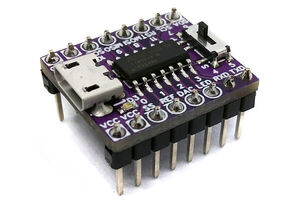
ATtiny x04/x14/x24 Development Board v2
"Development board for ATtiny x04/x14/x24 series with USB to serial converter, integrated SerialUPDI programmer and Arduino IDE support. " [...]
Secção Videos
Videos interessantes.
That's all Folks!



